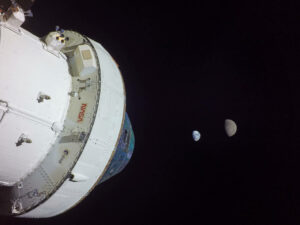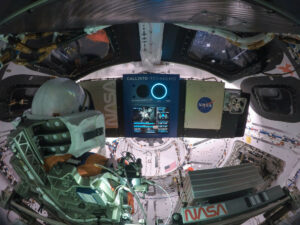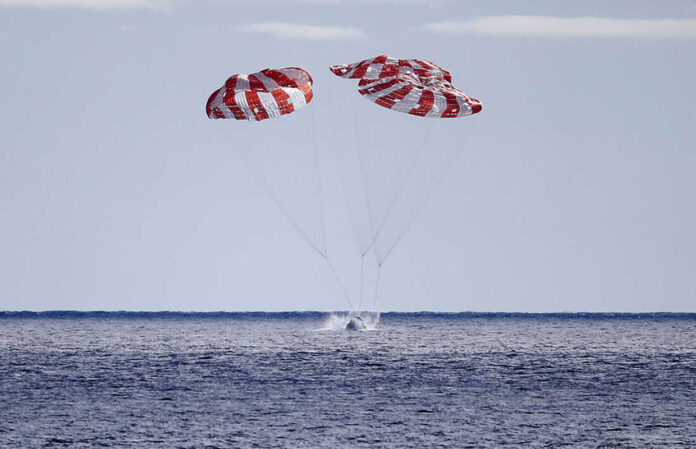WASHINGTON — Cited as the “crowning achievement of Artemis I,” the Orion spacecraft splashed down Sunday morning in the Pacific Ocean, capping a more than 1.4 million mile journey around the moon.
The uncrewed mission that launched Nov. 16 was an integrated flight test of the hardware and technology that will take humans back to the moon for the first time in more than five decades.
“The splashdown of the Orion spacecraft – which occurred 50 years to the day of the Apollo 17 moon landing – is the crowning achievement of Artemis I,” said NASA Administrator Bill Nelson. “From the launch of the world’s most powerful rocket to the exceptional journey around the moon and back to Earth, this flight test is a major step forward in the Artemis Generation of lunar exploration.
“It wouldn’t be possible without the incredible NASA team. For years, thousands of individuals have poured themselves into this mission, which is inspiring the world to work together to reach untouched cosmic shores.
“Today is a huge win for NASA, the United States, our international partners, and all of humanity.”

During the nearly 26-day mission, Orion performed two lunar flybys, coming within 80 miles of the lunar surface. At its farthest distance during the mission, Orion traveled nearly 270,000 miles from Earth, more than 1,000 times farther than where the International Space Station orbits, to intentionally stress systems before flying crew.
“With Orion safely returned to Earth we can begin to see our next mission on the horizon which will fly crew to the moon for the first time as a part of the next era of exploration,” said Jim Free, NASA associate administrator for the Exploration Systems Development Mission Directorate. “This begins our path to a regular cadence of missions and a sustained human presence at the moon for scientific discovery and to prepare for human missions to Mars.”
Prior to entering the Earth’s atmosphere, the crew module separated from its service module, which is the propulsive powerhouse provided by ESA. During re-entry, Orion endured temperatures of about 5,000 degrees Farenheit – about half as hot as the surface of the sun. Within about 20 minutes, Orion slowed from nearly 25,000 mph to about 20 mph for its parachute-assisted splashdown.
During the flight test, Orion stayed in space longer than any spacecraft designed for astronauts without docking to a space station. While in a distant lunar orbit, Orion surpassed the record for distance traveled by a spacecraft designed to carry humans, previously set during Apollo 13.
The next step is NASA’s Artemis II mission to launch a crewed flight on a mission to the moon and back. All elements for that mission are deep into assembly.
Work on Artemis III, which aims to put the first woman and person of color on the moon, is well under way with many of the systems, such as the propulsion for SLS and Orion, nearly complete.
The Artemis program constitutes an important national capability that leverages more than 3,800 suppliers and 60,000 workers across all 50 states. The program sustains an essential industrial base of large, mid-size and small companies that provide high-tech, professional jobs across the country.
In the coming days, Orion will return to shore where technicians will offload the spacecraft and transfer it by truck back to Kennedy. Once at Kennedy, teams will open the hatch and unload several payloads, including Commander Moonikin Campos, the space biology experiments, Snoopy, and the official flight kit.

Next, the capsule and its heat shield will undergo testing and analysis over the course of several months.
Several industry partners contributed to the successful mission.
Aerojet Rocketdyne provided the 39 propulsive elements to the mission, including the RS-25 and RL10 engines affixed to the core and upper stage that carried the SLS and Orion into orbit, as well as the jettison motor for the Orion spacecraft’s Launch Abort System.
Boeing is the prime contractor for the design, development, test and production of the launch vehicle core stage and upper stages as well as the development of the flight avionics suite.
Jacobs was responsible for the rocket’s final assembly, integration, testing, launch and recovery operations support, including development of the Artemis ground and launch control software used in the NASA Launch Control Center at Kennedy Space Center.
Lockheed Martin is the prime contractor for the Orion spacecraft, including the LAS, crew module and crew module adaptor.
Northrop Grumman contributed the twin solid rocket boosters that supplied more than 75% of the thrust at launch, as well as the abort motor and attitude control motor for the LAS.
Don’t miss out! Subscribe to our email newsletter to have all our smart stories delivered to your inbox.



